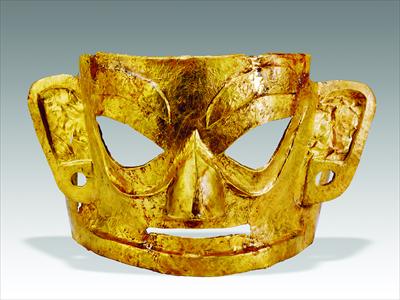
 |
| The 3,000-year-old Gold Mask can be viewed on the Jinsha Site Museum. Photo: Courtesy of the museum |
Despite covering over 200 museums from more than 40 countries across the world, the widely famous Google Art Project still has limited cooperation with China. The silver lining is that recently after Hunan Provincial Museum became the first public mainland museum to join its project in March this year, another local public museum, Jinsha Site Museum in Chengdu, Sichuan Province also joined in late May.
"Within a month of cooperating with Google Art Project, the page view of our museum at its website is in the hundreds of thousands," said Xiao Feige, director of the publicity department at Jinsha Site Museum. "Relying on this platform we can extend the recognition of Jinsha to people all over the world," Xiao told the Global Times.
Initiated in February 2011, the Google Art Project has developed into the world's largest online museum consortium website. The number of its total cultural relics displayed has been nearly 40,000 pieces. And the categories vary from paintings to sculptures, street art, photos, pottery and porcelains.
At the inception of the project, 17 top world museums including The Metropolitan Museum of Art of the US, The Palace of Versailles of France, and the Uffizi Gallery of Italy have been part of it. And last year, several museums from Taiwan and Hong Kong including Taipei's National Palace Museum, as well as the private museum UCCA (Ullens Center for Contemporary Art) of the mainland joined Google as the first group of Chinese museums in the art project.
High-definition clarity
"As to this cooperation, we provided 81 high-definition pictures of our relics, then they processed and uploaded them onto the Google Art Project website," said Xiao. Those selected relics are all of the most representative of the Jinsha Site, such as the Sun and Immortal Bird Gold Foil and Gold Mask, bearing culture elements from the late Shang Dynasty (1600-1046BC) to the Western Zhou Dynasty (1046-771BC).
Besides the high-definition browsing conditions, another highlight of the Google Art Project is the "trolley" service that will also be applied to the display of the Jinsha Site Museum. A dynamic view of the whole museum will be made into 7-billion-pixel ultra-high-definition pictures and videos through a special technology.
"Most of what the trolley service will show is the outdoor scenes of the Jinsha Site, and it is expected to be put in use online in August," Xiao introduced.
Google's unique trolley service separates itself from other museum online trials. It enables online visitors to view the scene as if they were touring the real museum.
Online trend
With technology having reached the point of showing the cracks and traces of time of an ancient relic, or the texture of the material used for a painting, online museum building has been a growing trend. "It is one of the directions for museums to realize modernization, the online parallel can inspire visitors' interests in visiting the actual museum," said Guo Xiaoling, president of the Capital Museum in Beijing.
"Many of the world's top museums have built their online museums so that many pictures are three-dimensional allowing visitors to observe objects from any angle," Guo noted.
In China, though most museums have just started to go digital, there are already several museums taking the lead in building their online museum, such as CAFA (Central Academy of Fine Arts) Art Museum, National Art Museum of China, The Palace Museum and the Capital Museum.
"Domestic museums now are generally walking on two legs to expand their reputation on the Internet," said Xiao, "One is to build their own website, the other is to rely on new media channels such as Google Art Project or the art channel of Baidu."
Both being a collective platform for museums to exhibit their collections online, domestic server Baidu's art channel is more filled with static illustrations and pictures, a little less dynamic user experience. "We have cooperation with Baidu too, but Google's webpage has more sense of design and it is more flexible in showing the relics to online visitors," said Xiao.
Sharing, but with concerns
Despite its advanced concept in online promotion for museums and convenient art provision for visitors staying indoors, the Google Art Project still causes its museum partners to be concerned, especially those large-scale public museums. In early 2012, Google showed its intention to cooperate with the CAFA Art Museum, a leading domestic public museum, in building its own online museum, but the discussions broke down.
"Unlike private museums, we have to be certain about important specifics like the issue of copyright," said Wang Huangsheng, president of CAFA Art Museum.
"Although they (Google) said that the pictures on their website cannot be duplicated, all the websites under Google can use those pictures and reproduce something out of them. I think this is risky," Wang told the Southern Metropolis Daily in an interview last year after the deal failed.
At the same time, the haphazard changing of pixel count for pictures also confused Wang. "They initially requested 50M for pictures, but when we questioned that the Internet use would not require such large pixel, they changed it to 10M," said Wang, "How can it be changed so easily?"
Choosing to cooperate or not, domestic museums have now stepped up efforts to build their own digital museums. And on the forefront of technology, they are not inferior to their foreign counterparts. Whether in the panoramic shooting or pictures' copyright protection, Chinese technology is no worse and sometimes even better than those used by Google, according to Ma Jiangang, whose team is responsible for the digital building of CAFA Art Museum.
"The gap lies in the concepts," said Xiao.
However, as global art has been connected to the Internet, it's important for domestic museums to also value the international platform to attract visitors from abroad. "Domestic museums should have their own as well as international online platforms, but one has to be clear about international rules before embarking on that ship," Wang emphasized.
















 Taiwan's average temperature in June reaches record high
Taiwan's average temperature in June reaches record high


![]()
